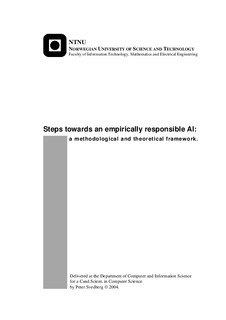| dc.contributor.advisor | Aamodt, Agnar | nb_NO |
| dc.contributor.advisor | Downing, Keith | nb_NO |
| dc.contributor.author | Svedberg, Peter O.S. | nb_NO |
| dc.date.accessioned | 2014-12-19T13:30:18Z | |
| dc.date.available | 2014-12-19T13:30:18Z | |
| dc.date.created | 2004-10-08 | nb_NO |
| dc.date.issued | 2004 | nb_NO |
| dc.identifier | 124846 | nb_NO |
| dc.identifier.isbn | 82-997022-0-8 | nb_NO |
| dc.identifier.uri | http://hdl.handle.net/11250/249929 | |
| dc.description.abstract | Initially we pursue a minimal model of a cognitive system. This in turn form the basis for the development of amethodological and theoretical framework. Two methodological requirements of the model are that explanation be from the perspective of the phenomena, and that we have structural determination. The minimal model is derived from the explanatory side of a biologically based cognitive science. Fransisco Varela is our principal source for this part. The model defines the relationship between a formally defined autonomous system and an environment, in such a way as to generate the world of the system, its actual environment. The minimal model is a modular explanation in that we find it on different levels in bio-cognitive systems, from the cell to small social groups. For the latter and for the role played by artefactual systems we bring in Edwin Hutchins' observational study of a cognitive system in action. This necessitates the introduction of a complementary form of explanation. A key aspect of Hutchins' findings is the social domain as environment for humans. Aspects of human cognitive abilities usually attributed to the person are more properly attributed to the social system, including artefactual systems.
Developing the methodological and theoretical framework means making a transition from the bio-cognitive to the computational. The two complementary forms of explanation are important for the ability to develop a methodology that supports the construction of actual systems. This has to be able to handle the transition from external determination of a system in design to internal determination (autonomy) in operation.
Once developed, the combined framework is evaluated in an application area. This is done by comparing the standard conception of the Semantic Web with how this notion looks from the perspective of the framework. This includes the development of the methodological framework as a metalevel external knowledge representation. A key difference between the two approaches is the directness by which the semantic is approached. Our perspective puts the focus on interaction and the structural regularities this engenders in the external representation. Regularities which in turn form the basis for machine processing. In this regard we see the relationship between representation and inference as analogous to the relationship between environment and system. Accordingly we have the social domain as environment for artefactual agents. For human level cognitive abilities the social domain as environment is important. We argue that a reasonable shortcut to systems we can relate to, about that very domain, is for artefactual agents to have an external representation of the social domain as environment. | nb_NO |
| dc.language | eng | nb_NO |
| dc.publisher | Institutt for datateknikk og informasjonsvitenskap | nb_NO |
| dc.subject | artificial intelligence | en_GB |
| dc.subject | ai | en_GB |
| dc.title | Steps towards an empirically responsible AI: a methodological and theoretical framework | nb_NO |
| dc.type | Master thesis | nb_NO |
| dc.source.pagenumber | 164 | nb_NO |
| dc.contributor.department | Norges teknisk-naturvitenskapelige universitet, Fakultet for informasjonsteknologi, matematikk og elektroteknikk, Institutt for datateknikk og informasjonsvitenskap | nb_NO |
